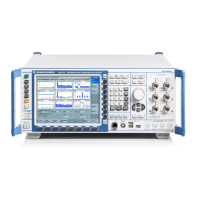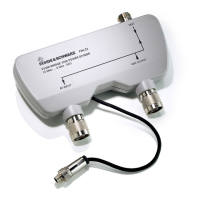Command Reference
R&S
®
CMW500
195User Manual 1173.9463.02 ─ 02
Command Parameters/
Remarks
Short Description
*SRE – Service
Request Enable
0...255 Sets the service request enable register to the value indicated.
Bit 6 (MSS mask bit) remains 0. This command determines under
which conditions a service request is triggered. The query *SRE?
returns the contents of the service request enable register in dec-
imal form. Bit 6 is always 0.
Alternatively *XSRE can be used with a comma separated list of
mnemonics enclosed in brackets. Mapping for bit 7, 5, 4, 3, 2:
OPER,ESBit,MAV,QUES,ERR. Example: *XSRE (ESBit,MAV)
sets bit 5 and 4 (ESB bit and MAV bit).
*SRQ? – Service
ReQuest
[timeout in ms]
query only, not IEEE
488.2-confirmed
Waits until a service request is generated (or the timeout expires)
and returns a status information:
●
1 indicates that a service request has been generated
●
0 indicates that the timer has expired (no service request)
If no timeout is specified and no service request is generated, the
command waits inifinitely. Other timers e.g. of the remote control
interface may expire in that case.
*STB? – STatus
Byte query
–
query only
Reads the contents of the status byte in decimal form.
Alternatively *XSTB? can be used to return the result as comma
separated list of mnemonics enclosed in brackets. For values see
*XPRE.
*WAI – WAIt to con-
tinue
–
no query
Prevents servicing of the subsequent commands until all preced-
ing commands have been executed and all signals have settled
(see also *OPC).
To perform this command for all sub-instruments use *GWAI
instead.
7.2 Emulation Codes
Remote control connections via USB, VXI-11 or GPIB support low-level control messages
(e.g. for polling) via interface functions. In contrast, a VISA socket resource provides no
protocol functions for this purpose. Instead emulation codes can be transferred to emulate
interface messages.
Most emulation codes are described in the IEEE 1174 standard. The following table pro-
vides an overview. Some messages depend on the protocol mode, see also Direct Socket
Communication.
Code Meaning Effect on the instrument
&ABO
&BRK
&DCL
(Abort)
(Break)
(Device Clear)
Aborts processing of the commands just received and sets the
command processing software to a defined initial state. Does not
change the instrument setting.
>L (Go to Local) Transition to the "Local" state (manual control).
&GET (Group Execute Trigger) Triggers a previously active device function (e.g. a sweep). The
effect of the command is the same as with that of a pulse at the
external trigger signal input.
>R (Go to Remote) Transition to the "Remote" state (remote control).
Emulation Codes

